If you like the look of white barked trees that have a lot of beauty and utility, then birch and aspen are among the first that come to mind. Classic and lovely, it can be hard to choose between them, so today we’re going to make things a little easier by giving you a deep-dive into the perks and pitfalls of both types of trees.
To keep things uncomplicated, we’ll tell you about River Birch and Quaking aspen trees – they are two stellar examples from the birch and aspen families – and much of the information will transfer to others of the corresponding species.
With that said, let’s get started with Birch vs Aspen trees: Identification tips and considerations for gardeners and find out which of these trees will be the best fit for you!
Bottom Line Up Front
Quaking aspens grow more quickly, but they propagate quickly so they’ll need a little extra maintenance. They do, however, provide a little mountain ambience for those who wax nostalgic for the aspens in their memories.
If you are just looking for shade, beautiful bark, and a little heat resistance in the bargain, though, then you really can’t beat River Birch. They’ll spring up almost as quickly and you won’t have as much maintenance to keep track of – always a plus when you’ve got a ‘full plate’ with your gardening choices!
Table of Contents
The Main Differences between Birch and Aspen trees
While we will take a more thorough look at both Birch and Aspen trees in the sections to follow, we’re going to start off with the most pronounced differences between each tree. Contrast is a great way to learn, after all, so let’s look at the main differences between Birch and Aspen trees so that you can use this as a foundation to build on.
The main differences between these two trees are as follows:
A cultivated Birch (Betula) typically grows up to 70 feet tall, with a spread approximately 35 feet wide, while Aspen trees (Populus Tremuloides) grow 40 – 50 feet tall with a 20 – 30 foot spread.
While both trees will have whitish bark and horizontal scarring, Aspen tree bark will have a greenish cast, as well as eye-shaped scarring at pronounced intervals as you look across it.
Birch trees have an average lifespan of around 60 to 90 years, while Aspens will typically live for 100 to 120 years.
Birch tree leaves tend to be elliptical or oval-shaped, while Aspen leaves are rather heart-shaped.
Birch Trees will grow 1.5 to 2 feet annually and Aspen, by contrast, typically grows 2 – 3 feet every year!
Aspen wood is lightweight and well-suited for building furniture, crates, and pulp for cardboard and paper applications. Birch is great for indoor work and veneers and it’s fairly waterproof, making it an excellent choice for building canoes.
Key Features: Birch

Now that we’ve gone into contrasts, we’re going to take a more thorough look at the Birch and the Aspen so that we can paint a more complete picture. Keep in mind that you’ll see some repeats from the differences, so that each individual tree profile section will be complete on its own. As there are 40 species of Birch, we’re going to give you the key aspects of River Birch (Betula) to keep things simple:
Birch leaves are elliptical or oval-shaped, approximately 1.5 to 3.5 inches long, and around 2.5 inches wide.
Birch bark is typically reddish-brown when young, with outer layers peeling off, and it may mature to an orange-brown or become more of a silver or whitish-gray and orange color as the tree matures.
River birch will have male and female catkins both visible on trees. They have a red-rust to purple coloration and the female buds will be shorter and stiffer than the male.
Birch is relatively fast growing, with a typical growth rate of 1.5 to 2 feet annually.
Fully grown, a Birch may be up to 70 feet tall with a 35 foot spread (on average).
The trees have a lifespan of approximately 60 to 90 years.
Aerated, slightly acidic, and well-draining soil is the preferred soil medium for Birch trees.
Pros
River birch is highly attractive for wildlife. Numerous birds, including waterfowl, may use it for shelter or snacking, and even deer seem to like these trees and may investigate the leaves.
River birch’s rooting system spreads out in an appreciable density in the soil, affixing the tree firmly in place and helping to prevent soil erosion in the process.
This species of birch is more disease-resistant than other birches and while birch borers are a risk, this is usually only when the tree is in a weakened state from insufficient water and excessive heat.
River birch is the most heat-resistant birch species, so much so that you’ll find it in the wild in many southern states.
Flood resistance helps to give this tree its name – River birch is sometimes found growing in sandbars and is more tolerant of damp soils than most other birch species.
For DIY types, this relatively fast-growing tree is an excellent source for plywood or veneer grade wood for your projects.
Cons
Not all of the wildlife you’ll attract with this birch is desirable. Sapsuckers, for instance, may be attracted to your River birches, although you can wrap the trees before they arrive to good effect. Walking sticks and Spiny Elm caterpillars are also a potential risk to the leaves.
River birch needs full sunlight – it won’t grow well in the shade.
These trees ‘shed’ a lot, especially when it gets very warm. Aside from twigs and bark peelings, it will also shed catkins in the spring, so you may need to put in some extra effort to keep things neat around your tree.
This tree is very sensitive about pH levels in the soil – if it’s not very acidic, then you’ll get yellowing leaves, but if it’s too acidic then there is a risk for Iron Chlorosis.
Key Features: Aspen
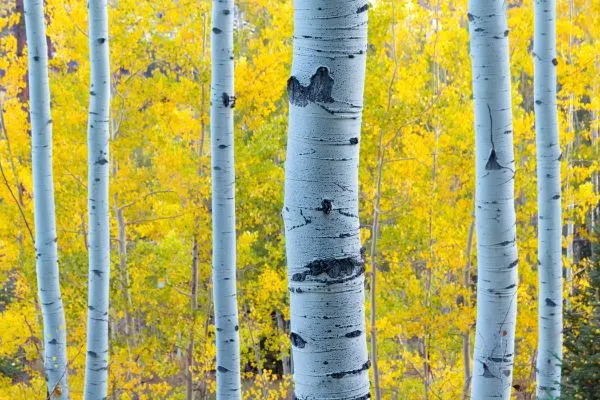
Now that we’ve had a closer look at River Birch, it’s time to give Aspen a turn. While there are 6 species of Aspen, we’ll keep things simple by going with the key aspects of the Quaking Aspen (Populus Tremuloides):
Quaking aspen leaves are triangular, almost heart-shaped, measuring 1.25 to 3 inches in length, with a 2-3 inch diameter.
Quaking aspen bark is thin and tends to be white or a white/greyish-green which becomes darker as it matures and is deeply furrowed, with eye-shaped scarring across the bark. Twigs tend to be more of a rusty brown, with a bit of a shine to their cast.
These trees produce purplish catkins with tiny white flowers and they are dioecious – you will find either only male or only female flowers on each Quaking aspen.
A very fast-growing tree, these aspens will grow 2 – 3 feet every year.
Fully grown, a Quaking aspen will typically be 40 to 50 feet tall, with a 20 to 30-foot spread.
These aspens have a lifespan of approximately 100 to 120 years.
Quaking aspens prefer moist soil and will thrive in loamy, sandy, acidic, well-drained, and clay soil mediums.
Pros
Fast-growing, the Quaking Aspen is a great way to cultivate that ‘mountain woodlands’ feel to your landscape.
For DIY types, Aspen can be made into pulp for homemade paper and is also ideal for furniture or create applications.
These trees have attractive, whitish bark, and the leaves take on a lovely yellow case in the autumn. Once nice feature is also chronicled via the ‘classical’ name of ‘tremuloides’, which describes how the leaves shake pleasingly in a light or spirited wind.
Quaking aspen attracts all sorts of wildlife, such as deer, rabbits, grouse, chipmunks, and numerous small birds!
These are hardy trees, which tend to thrive in areas where other trees might succumb to disease or insects.
Small enough that they won’t overwhelm your yard, they also propagate quickly enough to fill it nicely in only a few seasons.
Cons
We weren’t kidding about the deer – Quaking aspen is one of their favorite foods, so their appeal may be a mixed bag depending on your area.
Like birch, Quaking aspens are susceptible to iron chlorosis, so the soil should be slightly acidic but not overly so.
If the winters in your area fluctuate wildly, so that unseasonably warm days occur from time to time, bark may become discolored or even fall off.
Spider mites, caterpillars, and other insects are attracted to Quaking aspen, so this is something that you will need to prepare for.
Alternatives to Birch and Aspen trees
If you’d like to keep a few alternatives up your sleeve or simply want to have a very diverse selection of trees, then today’s your lucky day! We’ve got a few nice alternatives that we think you’ll like, so let’s test that by taking a look at them so that you can see what you think!
California Sycamore
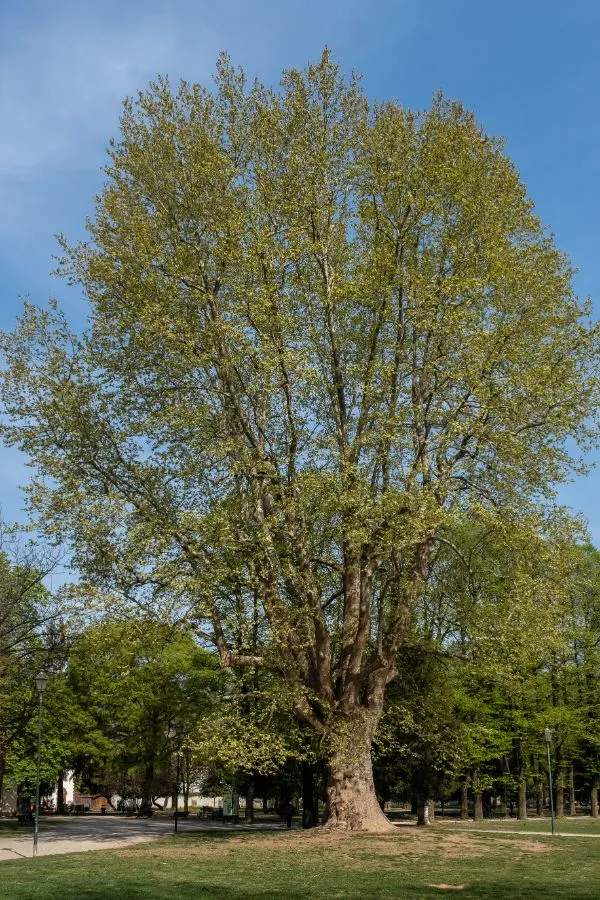
Platanus racemose, aka the ‘California Sycamore’, brings that white bark goodness that you want, and grows in just a little bit shorter than both Aspen and Birch. While smaller, it’s more heat-resistant, and will do well in hardiness zones ranging from 7 to 10.
Japanese Maple
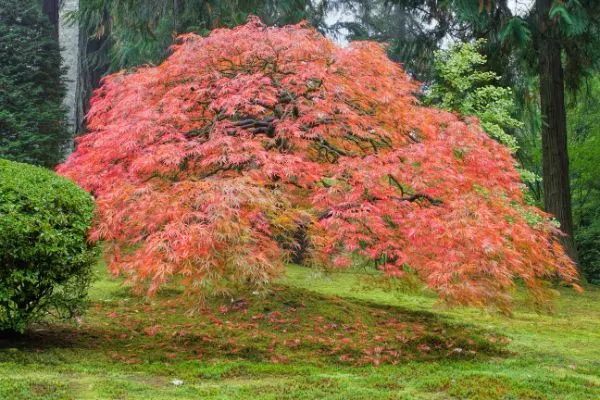
While it’s not white, the Acer palmatum or ‘Japanese Maple’ makes up for it with striking red leaves and bark. Smaller than both the birch and the aspen tree, some varieties of this such as ‘Glowing Embers’ are suitable for a 5 – 9 zone range, so be sure to pick your Japanese maple carefully to get the best look and fit for your environs.
Ghost Gum Tree
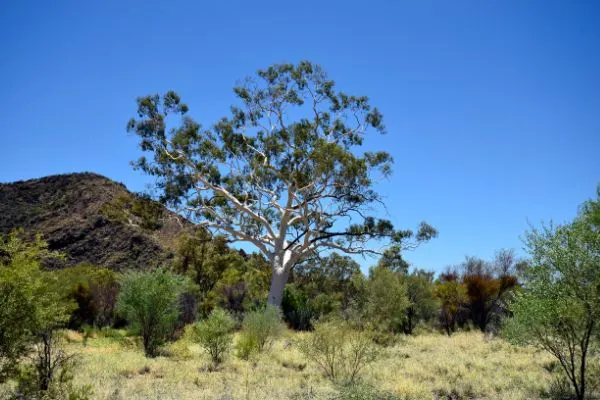
Ghost Gum, or more specifically ‘Corymbia aparrerinja’ will grow as tall and as wide as a birch, and also brings that sweet white bark to the table. This tree is actually a type of eucalyptus, so it will bring a nice fragrance to your yard, and it’s hardy enough to live in zones 8 to 10 – a definite plus if it gets a little hot in your area and drought is an occasional worry.
Before we close this section, if heat is a problem or you just want to spice things up a bit, don’t forget that fruit trees thrive in similar environments to birch and aspen, but they’ll take a little more heat and deliver sweet treats from time to time in the bargain.
Just a little food for thought!
Tips to help finalize your decision
Now that you have a healthy dose of the facts, let’s look at a few tips to help you decide whether birch or aspen is going to be the best fit for you:
- River birch is great for attracting wildlife, but don’t forget how much deer love to munch on it if you have a lot of them locally!
- Birch is quite heat-resistant, so it’s a better fit than Quaking aspen if you live in a warm environment.
- Quaking aspen can propagate quickly, which is nice for filling in a lot of area, but you’ll also have to deal with the sucker growths to keep it from spreading too much.
- While both trees grow very quickly, if you are looking for shade FAST then Quaking aspen will grow an extra foot per year in comparison to birch.
FAQ
Before we conclude this article, we’ll answer a few common questions that we get about both the River Birch and Quaking aspen from time to time. This will help to add the final touches to your mental picture of each tree and hopefully address anything that we might have missed!
Is River Birch a good yard tree?
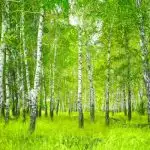
River birch is a great tree for the yard. It grows quickly and the spread helps to ensure excellent shade in the summers to come. When you add in the heat resistance and the colorful bark that will really show its stuff in the winter, River birch is really an excellent choice for your yard.
How far apart do River birch trees need to be?
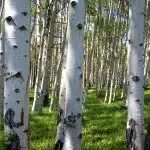
You can create a nice stand of them by planting the birch trees 6 to 10 feet apart, and some like to plant them in clumps of 3 – it really makes the white bark stand out nicely and will draw your attention time after time.
Do River birch trees damage foundations?

River birch tree roots will seek out water – this is the important thing to know. As long as they have a consistent source of water, then you won’t have to worry about your foundation. For good measure, don’t plant less than 20 feet away from your house and you should be okay.
Is the Quaking aspen tree good for a yard?
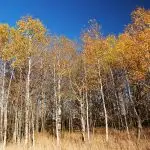
It really depends on the look that you are going for and how much work you are willing to put into it. If you like the ‘mountain chic’ look that they bring to the yard, then they can be an excellent fit, but you’ll need to deal with the suckering from these trees so that they don’t spread too quickly in your yard.
Do Quaking aspens require a lot of water?
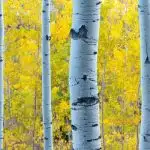
While they like soil that is moist or even a little wet, these trees will do well in semi-dry soil also, but when it gets really hot outside you’ll want to be sure that you water them once a week.
How close together can I plant Quaking aspen?

With Quaking aspen, the ideal distance apart between plantings will be 30 feet. This will help to accommodate the widespread and also to keep them more manageable.
Some final words regarding birch and aspen trees
Now that you’ve got all of the juicy facts at your disposal for these trees, which will you choose? The mountain mystique of the Quaking Aspen is a definite perk, and will definitely attract a lot of wildlife to your yard – just be sure to manage those sucklings or you’ll have more aspen than you bargained for!
Both trees are good for DIY uses, although Birch is a better fit for flooring or veneers, while you can make paper pulp with Aspen. If we had to pick one, however, then the River Birch would definitely be our favorite.
Low-maintenance and fast-growing, they are both ornamental and DIY practical, while costing you the least amount of time to maintain. While the ultimate decision will be up to you, our vote goes for the River Birch as the best of the pair unless you need to fill a space quickly and really love that classic mountain look!
We hope that you’ve enjoyed this article and until next time, we wish you and yours the very best!
More tree stuff
